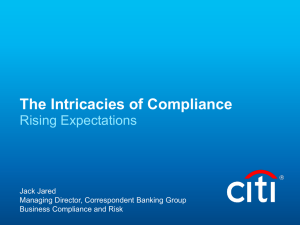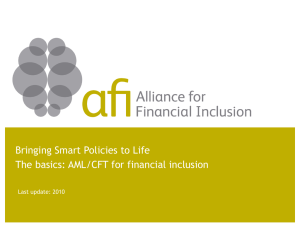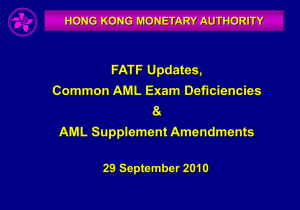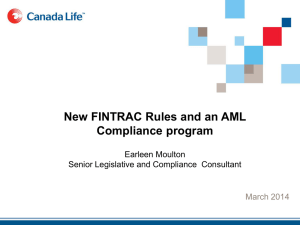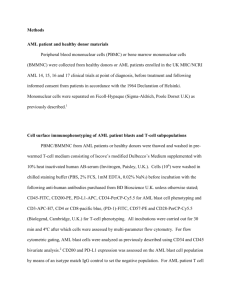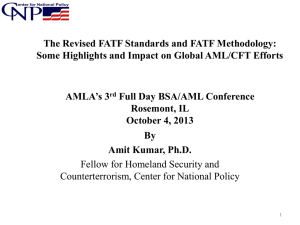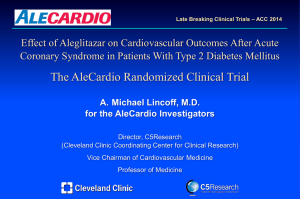Rudy Duschek presentation - Association of Canadian Compliance
advertisement
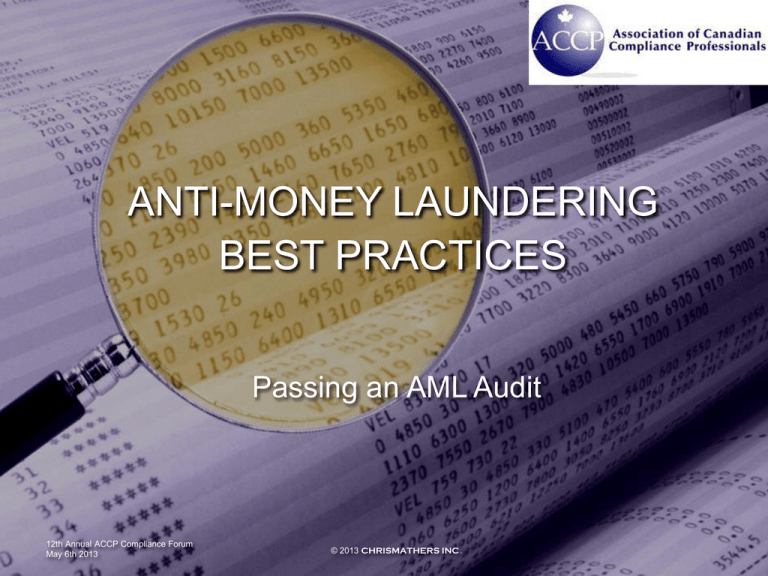
ANTI-MONEY LAUNDERING BEST PRACTICES Passing an AML Audit 12th Annual ACCP Compliance Forum May 6th 2013 © 2013 CHRISMATHERS INC. AML BEST PRACTICES It is the duty of a compliance officer to comfort the afflicted… … and to afflict the comfortable. AML BEST PRACTICES Could you pass an AML audit or field examination? • Evolution of AML regulations. • What does “passing” mean? • What are the regulators looking for? • Where is the “low hanging fruit” in a field examination? • What are the consequences of “failure”? AML BEST PRACTICES Summary of Significant Developments To Canadian Anti-Money Laundering Regulations 2000 2008 -2010 • Proceeds of Crime (Money Laundering) Act comes into force. • Act requires mandatory reporting of suspicious, and certain other, financial transactions. • FINTRAC established to analyze these reports and to release information to intelligence and law enforcement agencies. 2001 • Following 9/11, legislation changed to include countering the financing of terrorism and renamed PCMLTFA. Multiple substantive changes involving: • Reporting • Record Keeping • Ascertaining Identity • Politically Exposed Foreign Persons • Third Party Determination • Compliance Regime 2011 • Tax evasion and copyright infringement added to “designated offences” for suspicious transaction reporting 2013 - 2014 • Changes to the definition of business relationship, requirement to assess risk on an ongoing basis and to document results of assessment. AML BEST PRACTICES COMPLIANCE REGIME The following (summarized) 5 elements must be included in an anti-money laundering compliance regime: • Appointment of a compliance officer responsible for AML. • Written compliance policies and procedures. • Assessment and documentation of risks & measures to mitigate high risks. • Ongoing, program. written AML compliance training • Independent review of AML compliance regime at least every 2 years. AML BEST PRACTICES What does “passing” mean? • No jail time. • No AMP’s. • No “weaknesses” or “deficiencies”. AML BEST PRACTICES What are the regulators looking for? From you … • • • • • • Full compliance Documented risk assessment Documented risk mitigating procedures Timely filing (STRs, SATRs, LCTs, EFTs) Training Proper record keeping AML BEST PRACTICES What percentage of entities had no AML compliance regime? a. b. c. d. 7% 12% 20% 50% AML BEST PRACTICES WHY? Failure to: • • • • • • • • provide documents / cooperate. develop written compliance policy & procedures. assess and document risk. develop a written training program. keep information up to date. report EFTs, LCTs, etc. report on a timely basis. keep prescribed records. AML BEST PRACTICES What are the regulators looking for? K W About you … • • • • • Your business sector. Your business location. Your customers. Your affiliations. Trends. AML BEST PRACTICES Top destination or originating jurisdictions of electronic funds transfers related to suspected money laundering cases involving: ** Drug offences 1. 2. 3. 4. 5. 6. 7. 8. 9. 10. USA India Vietnam Hong Kong China Taiwan Iran United Kingdom Belarus Latvia Fraud offences (except securities fraud) 11. 12. 13. 14. 15. Switzerland Mexico Peru Israel Thailand ** Source: FINTRAC Typologies and Trends Reports – April 2012 1. 2. 3. 4. 5. 6. 7. 8. 9. 10. USA United Kingdom Iran Japan Hong Kong Israel Switzerland China Germany Italy 11. 12. 13. 14. 15. Austria France Cyprus Guernsey India AML BEST PRACTICES Top destination or originating jurisdictions of electronic funds transfers related to suspected money laundering cases involving: ** Securities fraud offences Suspected terrorist financing cases 1. USA 2. Netherlands Antilles 3. United Kingdom 4. China 5. Mexico 6. Bahamas 7. Antigua and Barbuda 8. Netherlands 9. Bermuda 1. USA 2. United Arab Emirates 3. Lebanon 4. Pakistan 5. United Kingdom 6. India 7. Austria 8. Netherlands 9. Iran 10. Hong Kong 10. Hong Kong 11. Panama 12. Dominican Republic 13. Turks and Caicos 14. Barbados 15. Luxembourg ** Source: FINTRAC Typologies and Trends Reports – April 2012 11. 12. 13. 14. 15. Sri Lanka Saudi Arabia Switzerland Hungary Turkey AML BEST PRACTICES Low Hanging Fruit - Field Examination Issues • • • • • • • • • • • Documented risk assessment 3rd Party Determination Beneficial Ownership PEFP determination, “look back” Failure to file STR’s ID - Expired / Photocopies / Non FTF issues Record Keeping (numerous issues) Entities – no confirmation of existence Charities - improper procedures Use of Agents Individual’s business or occupation AML BEST PRACTICES The Consequences of “Failure” • Naming and shaming. • You’re “on the list”. • Loss of business. • Reputation of Compliance Officer • A monetary penalty. AML BEST PRACTICES FINTRAC considers 3 criteria in determining the penalty amount: • the harm caused by the violation(s); • the compliance history of the reporting entity (5 years); and • the non-punitive nature of an administrative penalty. AML BEST PRACTICES Violations classified as: • Minor (individual / entity) • AMP $1 to $1,000 Recent asset procurement by regulators??? • Serious (individual / entity) • AMP $1 to $100,000 • Very Serious (individual) • AMP $1 to $100,000 • Very Serious (entity) • AMP $1 to $500,000 AML BEST PRACTICES The PCMLTFA: • Catching criminals or compliance officers? • $5B to $15B laundered in Canada annually. QUESTIONS??? (416) 860-8081 rduschek@chrismathers.com




